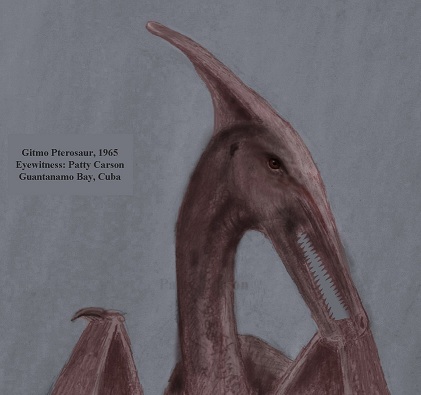In my book Searching for Ropens, I gave an arbitrary definition of the creature: “any featherless creature that flies in the Southwest Pacific, and has a tail-length more than 25% of its wingspan.” That definition is used on Wikipedia, sounding almost like a scientific definition, but I meant for it to be just a general clue about the nature of the general kind of animal. Since I first started investigating eyewitness accounts of apparent pterosaurs, I have looked forward to the day when one of their species will be officially acknowledged scientifically to be still living. Should that species be a short-tailed Pterodactyloid type, I would not want for it to be labeled “ropen,” for that name is for flying creatures with long tails, like the Umboi Island one.

“Gitmo Pterosaur” of southeast Cuba – a ropen or modern Rhamphorhynchoid
Fossil Discoveries and “Unlimited Common Ancestry” Philosophy
My associates and I respect the work of paleontologists who have analyzed and classified the pterosaur fossils that have so far been discovered. I expect other species will be classified in future fossil discoveries. But my associates and I have no confidence in the nineteenth-century philosophy handed down by Darwin: We have no respect for the unlimited-common-ancestry philosophy.
Common Beliefs Disbelieved
How does our disbelief in the General Theory of Evolution relate to the identity of the ropen? Many biologists and paleontologists assume that the long-tailed “basal” pterosaurs (Rhamphorhynchoid), in general, lived before the Pterodactyloid ones. They assume that the short-tailed ones were descended from the long-tailed, over millions of years. The word “basal” is used to signify that the long-tailed varieties were generally of the base of a family tree of pterosaurs. I know of no reason that this must be the case. But that belief in the ancient biology of Rhamphorhynchoids makes it even more difficult for many biologists and paleontologists to consider the possibility that the long-tailed pterosaurs are not completely extinct, that some species still live. I suggest that people evaluate old beliefs in light of new insights and observations.
Long Tails Outnumber Others
In 2011 I made a detailed evaluation of 98 sighting reports, the more credible of the countless eyewitness accounts worldwide. Those 98 were chosen because they appeared unlikely to have been from hoaxes and also unlikely to have been misidentifications of non-pterosaurs. I made some interesting observations, but let’s now look at only the data regarding long tails.
Sightings at night make it more difficult to see that a strange flying creature has or has not a long tail. Let’s look at the daylight sighting data. Of the thirty-seven sightings that were clearly in daylight, twenty-four (65%) included a clear declaration that the flying creature had a long tail. Some of the remaining thirteen may have been sightings of long tailed creatures but that feature was missed or not reported, in other words, long-tailed pterosaur-like flying creatures may outnumber all others by more than two-to-one.
In addition, many eyewitnesses of long-tailed pterosaurs report a structure at the end of the tail, strongly suggesting the Rhamphorhynchoid tail vane (also known as a “flange”). What does all that mean? The “basal” pterosaurs now dominate the world, flying in the face (I couldn’t resist that) of the common dogma that most long-tailed pterosaurs lived mostly millions of years before most of the short-tailed Pterodactyloids.
So What is the Ropen?
The ropen is a modern Rhamphorhynchoid pterosaur, the long-tailed type that is sometimes labeled “basal.”
The kongamato of Africa has been compared with the ropen of Papua New Guinea, in that similarly-described flying creatures have been associated with grave robbery.
Pterosaur Flies in Los Angeles County
Live pterodactyls flying over Los Angeles? It must be a low-budget Hollywood sci-fi, right? Wrong! From San Fernando Valley to Lakewood, Los Angeles County has reports of featherless flying creatures
Ropen Eyewitnesses in Papua New Guinea
American cryptozoologist Jonathan David Whitcomb interviews three native eyewitnesses of the ropen
Duane Hodgkinson, now a flight instructor in Livingston, Montana, in 1944 was stationed near Finschhafen, in what was then called New Guinea. After he and his buddy walked into a clearing, they were amazed as a large creature flew up into the air. The men soon realized that it was no bird that started to circle the clearing. It had a tail “at least ten to fifteen feet long,” . . .



One Reply to “What is a Ropen?”
Comments are closed.